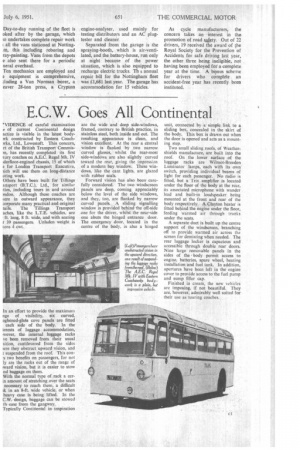E.C.W. Goes All Continental
Page 37

If you've noticed an error in this article please click here to report it so we can fix it.
'VlDENCE of careful examination ▪ of current Continental design
actice is visible in the latest bodywk constructed by Eastern Coachnics, Ltd., Lowestoft. This concern, rt of the British Transport Commism, has recently completed its first xury coaches on A.E.C. Regal Mk. IV Lderfloor-engined chassis, 15 of which
e for London Transport Executive, iich will use them on long-distance uring work.
Others have been built for Tiilings ansport (B.T.C.), Ltd., for similar ties, including tours in and around mclon. Although these coaches are vere in outward appearance, they 2,orporate many practical and original tails. The Tillings Transport aches, like the L.T.E. vehicles, are ft. long, 8 ft. wide, and with seating r 39 passengers. Unladen weight is Eons 4 cwt.
In an effort to provide the maximum nge of visibility, six curved, iighened-gla§s cove panels are fitted each side of the body. In the [crests of luggage accommodation, ■ wever, the internal luggage racks ve been removed from their usual sition, cantilevered from the sides lere they obstruct upward vision, and suspended from the roof. This cons two benefits on passengers, for not ly are the racks out of the range of iward vision, but it is easier to stow nd baggage on them.
With the normal type of rack a cerin amount of stretching over the seats necessary to reach them, a difficult dc in an 8-ft. wide vehicle, or when heavy case is being lifted. In the C.W. design, baggage can be stowed th ease from the gangway.
Typically Continental in inspiration
are the wide and deep side-windows, framed, contrary to British practice, in stainless steel, both inside and out. The resulting appearance is clean, and vision excellent. At the rear a central window is flanked by two narrow ' curved glasses, whilst the rear-most side-windows are also slightly curved toward the rear, giving the impression of a modern bay window. These windows, like the cant lights, are glazed with rubber seals.
Forward vision has also been carefully considered. The two windscreen panels are deep, coming appreciably below the level of the side windows, and they, too, are flanked by narrow curved panels, A sliding signalling window is provided behind the off-side one for the driver, whilst the near-side one abuts the hinged entrance door. The emergency door, located in the centre of the body, is also a hinged unit, connected by a simple link to a sliding box, concealed in the skirt of the body. This box is drawn out when the door is opened and acts as a mounting step.
Two small sliding roofs, of Weathershields manufacture, are built into the roof. On the lower surface of the luggage racks are Wilmot-Breeden Luminator lamps, each with its own switch, providing individual beams of light for each passenger. No radio is fitted, but a Trix amplifier is located under the floor of the body at the rear. its associated microphone with wander lead and built-in loudspeaker being mounted at the front and rear of the body respectively. A Clayton heater is fitted behind the engine under the floor, feeding warmed air through trunks under the seats.
A separate duct is built up the centre support of the windscreen, branching off to provide warmed air across the screen for demisting when needed. The rear luggage locker is capacious and accessible through double rear doors. Nine large removable panels in the sides of the body permit access to engine, batteries, spare wheel, heating installation and fuel tank. In addition, apertures have been left in the engine cover to provide access to the fuel pump and sump filler cap.
Finished in cream, the new vehicles arc imposing, if not beautiful. They are, however, admirably well suited for their use as touring coaches.
















































































